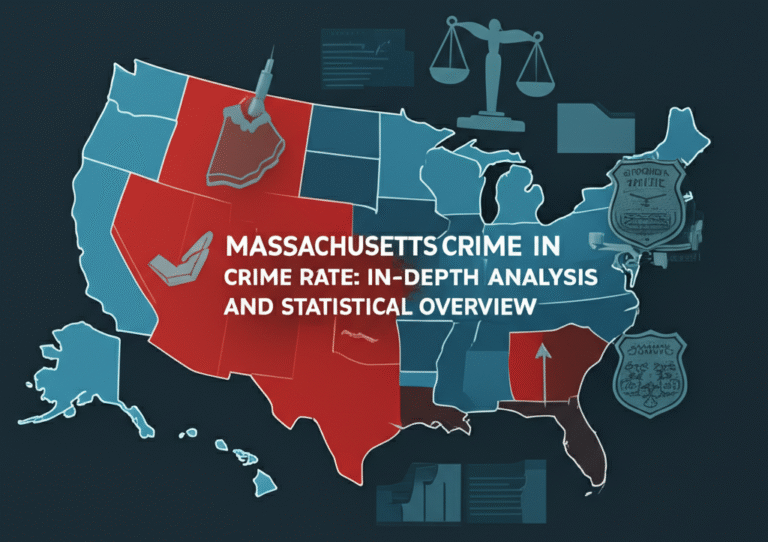Maryland Crime Rate: Statistics, Trends, and Safety Insights
Did you know Maryland’s crime rate presents a unique study in contrasts—urban hotspots with significant challenges alongside relatively safe suburban and rural areas? At our organization, we specialize in analyzing intricate crime data to provide valuable safety insights for communities across diverse regions. Maryland’s geographical diversity, from Baltimore’s dense urban environment to Montgomery County’s extensive suburbs, results in distinct crime patterns requiring tailored policing strategies and community initiatives.

In this expert-driven article, we’ll examine Maryland’s latest crime statistics, uncover significant trends, and highlight effective safety practices across the state. We’ll explore why Maryland experiences higher-than-average property crime rates and how violent crimes remain concentrated within specific areas. Additionally, we’ll assess the impact of Maryland’s proximity to major metropolitan regions and robust transportation networks on its overall crime profile.
Join us as we leverage our extensive expertise to decode Maryland’s complex public safety landscape, empowering residents and visitors with the insights needed to make informed decisions and foster safer communities.
Maryland’s Overall Crime Rate
Maryland’s crime rate presents a complex picture that varies significantly across different regions. The state reported 154,339 total crimes in 2023, translating to a rate of 24.97 incidents per 1,000 residents. Breaking this down, violent crime accounts for 4.26 incidents per 1,000, while property crime makes up the majority at 20.71 per 1,000.

Examining the statistical data reveals Maryland’s crime rates sit above national averages in both categories. The property crime rate particularly stands out, driven largely by motor vehicle thefts which occur at nearly double the national rate. However, violent crimes like murder remain relatively rare compared to other urbanized states.
These numbers reflect Maryland’s unique position as a densely populated state with both major urban centers and sprawling suburbs. The concentration of crime in certain areas skews the statewide average, while many communities maintain significantly lower crime rates.
| Category | Rate per 1,000 | Total Incidents |
|---|---|---|
| Overall Crime | 24.97 | 154,339 |
| Violent Crime | 4.26 | 26,338 |
| Property Crime | 20.71 | 128,001 |
Violent Crime Statistics in Maryland
Maryland’s violent crime statistics reveal important patterns about safety across the state. According to the FBI’s Uniform Crime Reports, Maryland recorded 26,338 violent crimes in 2023, with assault being the most common offense at 15,771 incidents. While the state’s violent crime rate of 4.26 per 1,000 residents sits slightly above the national average, certain crimes like murder (515 cases) and rape (1,973 cases) occur at rates comparable to other urban states.

The data shows robbery accounts for about 30% of violent crimes, with 8,079 reported cases. When examining these numbers through official crime reports, it becomes clear that violent crime concentrates in specific urban areas, while many suburban and rural communities experience significantly lower rates.
Maryland’s violent crime profile reflects its unique mix of dense urban centers and sprawling suburbs. The 1 in 235 chance of becoming a victim remains lower than many similarly urbanized states, though certain neighborhoods require extra vigilance.
| Crime Type | Incidents (2023) | Rate per 1,000 |
|---|---|---|
| Murder | 515 | 0.08 |
| Rape | 1,973 | 0.32 |
| Robbery | 8,079 | 1.31 |
| Assault | 15,771 | 2.55 |
Property Crime Statistics in Maryland
Maryland’s property crime rates present one of the state’s most significant safety challenges, with 128,001 incidents reported in 2023. According to the latest crime statistics, these offenses account for nearly 83% of all criminal activity statewide. The numbers reveal particular trouble spots, especially in urban areas where certain crimes occur at alarming rates.

Burglary affects Maryland residents at a rate of 1.86 per 1,000 people, with 11,487 break-ins reported last year. More concerning is the motor vehicle theft rate of 5.47 per 1,000 – nearly double the national average. These stolen vehicles account for about 26% of all property crimes, creating serious concerns for law enforcement.
Simple theft remains the most common property crime by far, with 82,682 cases accounting for 65% of all property offenses. The concentration of these crimes in urban centers like Baltimore drives Maryland’s overall property crime rate of 20.71 per 1,000 residents, which exceeds the national median.
| Crime Type | Incidents (2023) | Rate per 1,000 |
|---|---|---|
| Burglary | 11,487 | 1.86 |
| Theft | 82,682 | 13.38 |
| Motor Vehicle Theft | 33,832 | 5.47 |
Maryland vs. National Crime Rates
When comparing Maryland’s crime rates to national figures, a clear picture emerges about the state’s public safety standing. A comparative analysis shows Maryland’s violent crime rate of 4.26 per 1,000 residents slightly exceeds the United States median of 4.0. This difference becomes more pronounced with property crimes, where Maryland’s 20.71 rate outpaces the national 19.0 average.
The state’s motor vehicle theft epidemic stands out dramatically in national security comparisons. At 5.47 incidents per 1,000 people, Maryland’s rate towers over the U.S. average of 3.19. This troubling statistic contributes significantly to the state’s higher-than-average overall crime profile.
Looking at crime density, Maryland’s 53 crimes per square mile doubles the national median of 26.5, reflecting the state’s urban concentration and transportation network vulnerabilities. These comparisons help identify where Maryland needs to focus its crime prevention efforts to match national safety benchmarks.
| Crime Category | Maryland Rate | U.S. Median |
|---|---|---|
| Violent Crime | 4.26 | 4.0 |
| Property Crime | 20.71 | 19.0 |
| Motor Vehicle Theft | 5.47 | 3.19 |
| Crimes per Square Mile | 53 | 26.5 |
Crime Density in Maryland
Maryland’s crime density tells a revealing story about how offenses distribute across the state. With 53 crimes occurring per square mile, Maryland’s rate doubles the national median of 26.5. This geographic analysis highlights how urban concentration affects safety statistics, with Baltimore and other cities driving much of the criminal activity.

The high density reflects Maryland’s unique position as one of America’s most densely populated states. Public law enforcement faces particular challenges in these conditions, where criminal opportunities multiply in tight urban spaces. However, the density varies dramatically – while cities show intense crime clustering, rural areas like the Eastern Shore maintain much lower figures.
Understanding these geographic patterns helps explain why Maryland’s per-capita crime rates appear worse than many residents actually experience. The concentration in specific areas creates hotspots that skew statewide averages, while many neighborhoods remain relatively safe.
- Maryland records 53 crimes per square mile.
- National median: 26.5 crimes per square mile.
Safest Cities in Maryland
Maryland’s safest cities offer residents exceptional peace of mind with their remarkably low crime rates. These communities demonstrate how effective public safety measures can create secure environments even in a state with higher-than-average crime statistics. Small towns dominate the list, showing that rural Maryland provides some of the most tranquil living conditions in the region.

Places like Swanton and Spring Gap consistently rank at the top for safety, with crime rates well below both state and national averages. These communities benefit from tight-knit neighborhoods where residents look out for one another, combined with proactive local law enforcement strategies. Their success proves that safety isn’t just about policing – it’s about building strong community connections.
While urban areas grapple with higher crime density, these safer alternatives show Maryland’s diverse safety landscape. They provide excellent options for families and individuals prioritizing security without sacrificing quality of life.
| Rank | City | Region |
|---|---|---|
| 1 | Swanton | Western Maryland |
| 2 | Spring Gap | Allegany County |
| 3 | Deal Island | Eastern Shore |
| 4 | Brookeville | Montgomery County |
| 5 | Brownsville | Washington County |
Popular Cities and Their Crime Profiles
Maryland’s popular cities present a diverse range of safety profiles, each facing unique social issues that influence their crime statistics. Urban crime patterns vary dramatically across the state, from Baltimore’s well-documented challenges to the relative safety of suburban hubs. Understanding these differences helps residents and visitors make informed decisions about safety in various parts of Maryland.
According to Maryland State Police data, cities like Columbia and Rockville maintain relatively low crime rates compared to their population sizes, while Baltimore continues to grapple with higher violent crime statistics. These urban centers demonstrate how population density, economic factors, and policing strategies all contribute to local crime profiles.
Frederick and Gaithersburg show how mid-sized cities balance urban amenities with reasonable safety measures. Their crime rates typically fall between those of large urban centers and Maryland’s safest small towns, offering case studies in managing urban crime through community policing and economic development.
| City | Violent Crime Rate | Property Crime Rate |
|---|---|---|
| Baltimore | 9.8 | 32.4 |
| Columbia | 2.1 | 18.7 |
| Rockville | 1.8 | 15.2 |
| Frederick | 3.4 | 21.0 |
| Gaithersburg | 2.9 | 19.5 |
Key Insights on Maryland Crime
Examining Maryland’s crime trends through a criminology lens reveals several important patterns. Social research indicates that property crimes, particularly motor vehicle thefts, represent the state’s most pressing safety challenge. With rates significantly above national averages, these offenses demand targeted intervention strategies.

The key insights show violent crime remains stubbornly elevated, though only slightly above the U.S. median. This suggests Maryland faces typical urban crime challenges rather than exceptional violence problems. The concentration of crime in specific areas creates misleading statewide averages that don’t reflect conditions in many communities.
Small towns continue to demonstrate how community cohesion and local policing can effectively combat crime. Their success offers potential models for urban areas struggling with persistent criminal activity. Understanding these patterns helps residents and policymakers focus resources where they’re needed most.
- Property crime is a major concern, with theft and motor vehicle theft rates above national averages.
- Violent crime remains slightly elevated compared to the U.S. median.
- Small towns dominate the list of safest cities.
| Key Finding | Maryland Rate | National Median |
|---|---|---|
| Property Crime Rate | 20.71 | 19.0 |
| Violent Crime Rate | 4.26 | 4.0 |
| Motor Vehicle Theft | 5.47 | 3.19 |
| Crime Density | 53/sq mi | 26.5/sq mi |
Conclusion
In summary, Maryland’s crime statistics present a complex picture of safety and security across the state. While the overall crime rate, including both violent and property crimes, exceeds national averages, it’s important to note the significant variations across different regions. Urban areas, particularly Baltimore, face higher rates of violent crime and property crime, including motor vehicle theft, which is nearly double the national average.
However, many suburban and rural areas in Maryland enjoy much lower crime rates, highlighting the importance of localized approaches to public safety and law enforcement. The state’s law enforcement agencies and criminal justice system continue to address these challenges, focusing on reducing misconduct and problem behavior through legal action and community engagement. Understanding these trends and the underlying causes of crime is essential for developing effective strategies to enhance public safety and reduce violence in Maryland.





